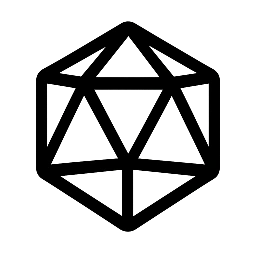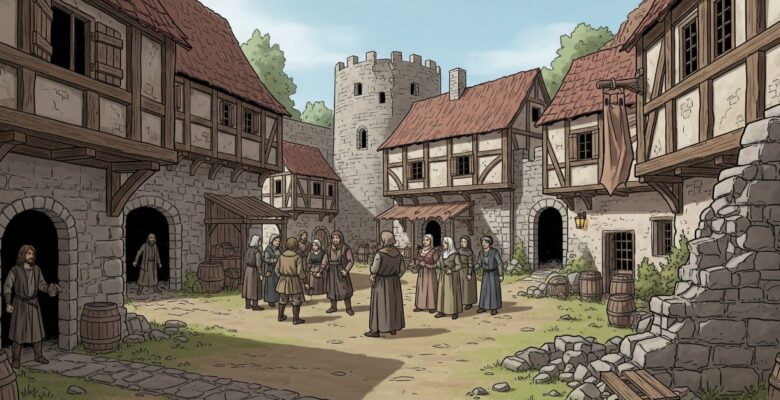In a hobby where high fantasy and cinematic adventure often dominate the landscape, HârnWorld stands apart as a meticulously crafted, low-fantasy setting rooted in realism, consistency, and immersive worldbuilding. Published by Columbia Games since the 1980s and still actively supported today, HârnWorld offers something rare in tabletop RPGs: a living, breathing world that feels like it could exist in a forgotten corner of Earth’s own history.
Whether you’re a Game Master seeking a richly detailed setting or a player looking to inhabit believable characters in a grounded medieval world, HârnWorld is a compelling, if niche, choice. It’s a system-agnostic setting that places realism, politics, and cultural depth above magic and monsters—and it does so brilliantly.
🌍 Setting Overview: A Medieval World Without the Gloss
HârnWorld is set on the island of Hârn, one part of a larger continent called Kethira. While fantasy elements exist, they are rare and subdued. The setting’s emphasis is on medieval realism, inspired by 12th-century Western Europe with added fictional geography, religions, and cultures. The result is a world that feels authentic and consistent, encouraging players and GMs to engage with social dynamics, political intrigue, feudal systems, and historical development rather than dungeon delving or magic item collection.
You won’t find dragon-slaying epics or world-shattering artifacts in every corner. Instead, you’ll encounter clan rivalries, noble disputes, religious tensions, and the slow grind of rural life, all documented in loving detail.
🛡️ System Neutrality
One of the key strengths of HârnWorld is that it is system-neutral. While Columbia Games also publishes HârnMaster, a crunchy ruleset designed for gritty realism, HârnWorld can be used with virtually any RPG system, including D&D, RuneQuest, GURPS, Mythras, or your own homebrew rules.
Everything in HârnWorld is presented in terms of setting—maps, characters, cultures, governments, and histories—without specific game mechanics. This makes it extremely flexible, especially for GMs looking to inject believable lore into their existing games without overhauling mechanics.
🗺️ Maps and Geography: The Gold Standard
If HârnWorld is known for one thing, it’s the maps. Every kingdom, city, castle, and village is mapped with obsessive precision. Cartography in Hârn isn’t just a visual aid—it’s a storytelling tool.
- Color regional maps show borders, roads, and terrain
- Detailed city maps reveal every alley, shop, and stronghold
- Site-specific diagrams offer insight into buildings like manors, temples, or fortresses
These maps are not just beautiful—they’re functional. They give GMs instant storytelling prompts and ground the players’ actions in a tangible space. If a noble lives in a manor two streets from the cathedral, you’ll know exactly where—and what it looks like.
📚 Supplements and Modules
HârnWorld is modular. The core product provides a sweeping overview of the island, including:
- History and calendar systems
- Economics and coinage
- Geography and climate
- Languages and cultures
- Religion and pantheons
- Governmental systems
From there, you can expand as you wish. Columbia Games and Kelestia Productions (a separate but closely aligned publisher) have released dozens of supplements, each focusing on specific kingdoms, cities, noble families, or topics like guilds, magic, or trade. These supplements are written with the same consistent tone and offer immense depth.
For example, the Kingdom of Kaldor module doesn’t just name rulers and cities—it details land inheritance laws, court intrigue, vassal obligations, and even the economic output of fiefdoms.
🧙 Magic, Monsters, and Religion
Unlike most fantasy settings, HârnWorld keeps magic and monsters rare and mysterious. Wizards exist, but they’re secretive and distrusted. Magical phenomena are subtle and open to interpretation. Creatures like gargun (orc-like beings) exist, but are not common foes on every corner—they are part of a broader ecosystem, with tribal dynamics and migration patterns.
Religion plays a central role in Hârn, with ten primary gods represented by competing churches, sects, and heresies. Religious belief isn’t just window dressing—it affects daily life, laws, and politics. Temples collect tithes, declare crusades, and influence noble families, much like medieval Christianity and Islam in our own world.
For players who enjoy magic as a utility or power fantasy, HârnWorld may feel too grounded. But for those interested in subtle mysticism, divine politics, and the occasional forbidden spell, it offers a compelling and restrained alternative.
🎲 Gameplay Experience
While HârnWorld doesn’t include a rules system, it naturally lends itself to character-driven, story-rich campaigns. Adventures in Hârn often involve:
- Political intrigue and dynastic succession
- Merchant ventures, trade routes, and taxation
- Religious debates or holy missions
- Exploration of ancient ruins from a lost civilization (the Earthmasters)
- Crime, justice, and social hierarchy
This makes HârnWorld ideal for sandbox campaigns, where players forge their own goals and react to a world in motion. GMs who enjoy immersive prep and consistent world logic will find it immensely rewarding.
However, GMs looking for plug-and-play monster encounters or magic-laden loot tables may find Hârn less accommodating. This is a world that asks you to slow down, think deeply, and consider the implications of every action—just as real-world medieval society might.
✅ Strengths
- Unparalleled worldbuilding depth and internal consistency
- System-neutral—compatible with most TTRPG systems
- Best-in-class cartography and visual aids
- Rich political, social, and religious dynamics
- Expansive library of supplements that allow deep customization
⚠️ Weaknesses
- Overwhelming for newcomers due to its density and realism
- Lacks mechanical support, requiring system conversion or pairing with HârnMaster
- Low-magic tone may not appeal to all players
- Slower pacing, better suited for long-term campaigns than episodic play
🧭 Final Verdict
HârnWorld is not for everyone—but for the right GM and group, it’s a masterclass in worldbuilding. It’s one of the few RPG settings that feels like it could function without player characters—because the world, its cultures, and its people are already moving, growing, and changing on their own.
If you’re tired of generic fantasy settings or looking to ground your game in nuance, realism, and authenticity, HârnWorld is a treasure trove. It rewards prep, encourages curiosity, and invites you to take your storytelling to the next level.

